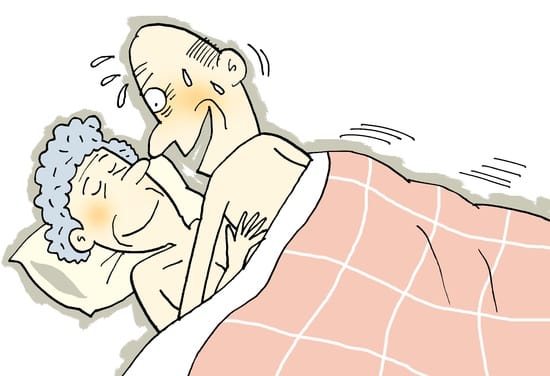Composite case studies have been selected to identify and illustrate the dysfunctional characteristics of the male aging process.
Both Mr. and Mrs. A were 66 and 62 years of age when referred to the Foundation for sexual inadequacy. They had been married 39 years and had three children, the youngest of whom was 23 years of age. All children were married and living outside the home.
They had maintained reasonably effective sexual interchange during their marriage.
Mr. A had no difficulty with erection, reasonable ejaculatory control, and, aside from two occasions of prostitute exposure, had been fully committed to the marriage. Mrs. A occasionally orgasmic during intercourse and regularly orgasmic during her occasional masturbatory experiences had continued regularity of coital exposure with her husband until five years before referral for therapy.
Mr. A had recently retired from a major manufacturing concern. He had been relatively successful in his work and there were no specific financial problems facing man and wife during their declining years.
Both members of the marital unit had enjoyed good health throughout the marriage. At age 61, he had taken his wife abroad on a vacation trip which entailed many sightseeing trips with a different city on the agenda almost every day.
They were chronically tired during the exhausting trip, but because they were on vacation and away from home there was a definite increase over the established frequency of coital connections. Mr. A noted for the first time slowed erective attainment.
Regardless of his level of sexual interest or the depth of his wife’s commitment to the specific sexual experience, it took him progressively longer to attain a full erection. With each sexual exposure his concern for the delay in erective security increased until finally, just before termination of the vacation trip, he failed for the first time to achieve an erection quality sufficient for vaginal penetration.
When the coital opportunity first developed after return home, erection was attained, but again it was quite slow in development. The next two opportunities were only partially successful from an erective point of view, and thereafter he was secondarily impotent.
After several months they consulted their physician and were assured that this loss of erective power comes to all men as they age and that there was nothing to be done. Loath to accept the verdict, they tried on several occasions to force an erection with no success. Mr. A was seriously depressed for several months but recovered without apparent incident.
Approximately 18 months after the vacation trip, the couple had accepted their “fate.” The impotence was acknowledged to be a natural result of the aging process. This resigned attitude lasted approximately four years.
Although initially the marital unit and their physician had fallen into the socio-cultural trap of accepting the concept of sexual inadequacy as an aging phenomenon, the more Mr. and Mrs. A considered their dysfunction the less willing they were to accept the blanket concept that lack of erective security was purely the result of the aging process.
They reasoned that they were in good health, had no basic concerns as a marital unit, and took good care of themselves physically. Therefore, why was this dysfunction to be expected simply because some of their friends reportedly had accepted the loss of male erective prowess as a natural occurrence?
Each partner underwent a thorough medical checkup and sought several authoritative opinions, refusing to accept the concept of the irreversibility of their sexual distress. Finally, approximately five years after the onset of a full degree of secondary impotence, they were referred for treatment.
Sexual functioning was reconstituted for this marital unit within the first week after they arrived at the Foundation and as soon as they could absorb and accept the basic material directed toward the variation in the physiological functioning of the aging male.
No longer were they concerned with the delay in erective attainment; there were no more attempts to will, force, or strain to accomplish erection under assumed pressures of performance.
In short:
They needed only the security of the knowledge that the response pattern which initially had raised the basic fear of dysfunction was a perfectly natural result of the involutional process.
When they could accept the fact that it naturally took longer for an older man to achieve an erection, particularly if he were tired or distracted, the basis for their own sexual inadequacy disappeared.
Some six years after termination of the acute phase of therapy, this couple, now in the early seventies and late sixties, continue coital connection once or twice a week.
The husband has learned to ejaculate on his own demand schedule, and neither partner attempts a rapid return to sexual function after a mutually satisfactory sexual episode.
The husband, age 62, and his wife, age 63, were referred to the Foundation. They had two children, both of whom were married and lived out of the home.
Their sexual dysfunction had begun when the husband was 57 years old. He had noted some delay in attaining erection and marked reduction in ejaculatory volume and was particularly concerned with the fact that the ejaculatory experience was one of the mere dribbling of seminal fluid from the external urethral meatus, under obviously reduced pressure.
All these involutional signs and symptoms developed within approximately a year after he had noticed some delay in onset of erection attainment.
The more he worried about his symptoms the more frequent the occasions of impotence.
Mrs. B was completely convinced that this pattern of sexual involution was true to be expected as part of the aging process.
Rather than distress her husband, she suggested that they use separate bedrooms.
She changed from a pattern of free and easy exchange of sexual demand to one of availability for coital connection only at her husband’s expression of interest. To resolve her own sexual tensions, she masturbated about once every ten days to two weeks without her husband’s knowledge.
Finally, Mr. B developed severe prostatic spasm with ejaculation during approximately half the increasingly rare occasions when there was sufficient erective security to establish a coital connection. It was the persistence of this symptom of pain that first brought medical consultation and ultimately referral for treatment.
In the evaluation of this man during the physical examination, there was marked muscular weakness noted, a history of easy fatigability, and increasing lassitude in physical expression.
Mr. B also had been distressed in the last two to three years before referral to therapy with distinct memory loss for recent events. He described the loss of work effectiveness for approximately the same length of time.
With these overt symptoms suggestive of steroid starvation, testosterone replacement was initiated empirically. Within those days there was a partial return of ejaculatory pressure and a moderate shortening of the time span for the delayed erective reaction. The prostatic pain did not recur.
Once Mrs. B could accept the explanation for the onset of her husband’s sexual dysfunction, she was pleased to return to the role of an active sexual partner. The coital connection has continued regularly for the past three years with both members of the marital unit supported by steroid-replacement techniques.
In brief, for the sexually dysfunctional aging male, the primary concern is one of education so that both the man and his wife can understand the natural involutional changes that can develop within their established pattern of sexual performance.
Sex steroid replacement should be employed only if definite physical evidence of the male climacteric exists. As the newer techniques for establishing testosterone levels in blood serum become more widely disseminated, it will be infinitely easier to define and describe the male climacteric and therefore to offer testosterone replacement to those who need it, on a more definitive basis than an empirical diagnosis.
With effective dissemination of information by proper authority, the aging man can be expected to continue in a sexually effective manner into his ninth decade. Fears of performance are engendered by a lack of knowledge of the natural involutional changes in male sexual responsivity that accompany the aging process.
Really, the only factor that the aging male must understand is that loss of erective prowess is not a natural component of aging.
Statistical evaluation of the aging population and a consideration of treatment failure rates will constitute the following section. This material arbitrarily has been placed in the male rather than the female.
First, it was felt important to keep the statistical consideration of the aging marital units together, and second, because there were 56 males So years old or over in marital units accepted for treatment and only 37 wives 50 or older, it seemed appropriate to include the brief statistical discussion in the chapter reflecting the larger segment of the aging population.












